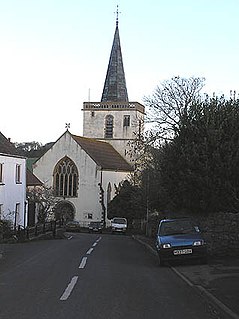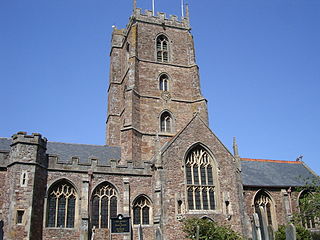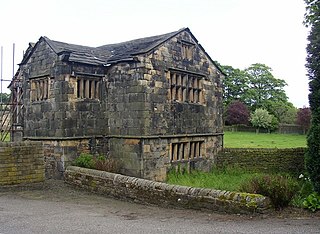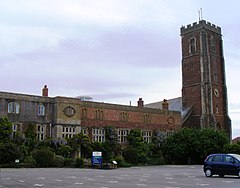
Arthington Priory was an English monastery which was home to a community of nuns in Arthington, West Yorkshire, founded in the mid-12th century. The priory land is occupied by a residence called "Arthington Hall", which was built around 1585, and little, if anything, remains of the priory. The site of the priory church is possibly now occupied by a farmhouse called The Nunnery. The community was the only one of nuns of the Cluniac congregation in Yorkshire and one of two in England. It was established through a grant by Peter de Arthington.

Stogursey is the name of a small village and civil parish in the Quantock Hills in Somerset, England. It is situated 3 miles (4.8 km) from Nether Stowey, and 8 miles (12.9 km) west of Bridgwater. The village is situated near the Bristol Channel, which bounds the parish on the north.
Amesbury Abbey was a Benedictine abbey of women at Amesbury in Wiltshire, England, founded by Queen Ælfthryth in about the year 979 on what may have been the site of an earlier monastery. The abbey was dissolved in 1177 by Henry II, who founded in its place a house of the Order of Fontevraud, known as Amesbury Priory.
Saint Mary's Abbey in Colwich, Staffordshire was a monastery of Roman Catholic nuns of the English Benedictine Congregation, founded in 1623 at Cambrai, Flanders, in the Spanish Netherlands, and closed down in 2020. During the French Revolution, the community was expelled from France and settled at The Mount, Colwich, in 1836, where it remained for the next 84 years.

Cannington is a village and civil parish 3 miles (5 km) northwest of Bridgwater in the Sedgemoor district of Somerset, England. It lies on the west bank of the River Parret, and contains the hamlet of Edstock.

Ecclesfield Priory was a religious house of Benedictine monks, lying in the village of Ecclesfield, north of Sheffield in Yorkshire, England.

The Grade I listed buildings in Somerset, England, demonstrate the history and diversity of its architecture. The ceremonial county of Somerset consists of a non-metropolitan county, administered by Somerset County Council, which is divided into five districts, and two unitary authorities. The districts of Somerset are West Somerset, South Somerset, Taunton Deane, Mendip and Sedgemoor. The two administratively independent unitary authorities, which were established on 1 April 1996 following the breakup of the county of Avon, are North Somerset and Bath and North East Somerset. These unitary authorities include areas that were once part of Somerset before the creation of Avon in 1974.

The Church of St Andrew in Stogursey, Somerset, England dates from the early 12th century and has been designated as a Grade I listed building.

The Church of St Mary is the parish church of Cannington, Somerset, England. The parish is in the Church of England Diocese of Bath and Wells.

Cannington Priory was a Benedictine nunnery established around 1138 and dissolved in 1536 in Cannington, Somerset, England.

Dunster Priory was established as a Benedictine monastery around 1100 in Dunster, Somerset, England.

St Radegund's Priory, Cambridge was a Benedictine nunnery in Cambridge, Cambridgeshire, England. It was founded before 1144 and dissolved in 1496 by the initiative of John Alcock, Bishop of Ely.
Moxby Priory is the commonly used name of the former Augustinian nunnery of S. John the Apostle in today's parish of Marton-cum-Moxby, North Yorkshire, England.

Nun Appleton Priory was a priory near Appleton Roebuck, North Yorkshire, England. It was founded as a nunnery c. 1150, by Eustace de Merch and his wife. It was dissolved by 1539, when the nuns were receiving pensions.
Wolston Priory was a Benedictine priory near Wolston in Warwickshire, England. The earthwork remains of the priory are a Scheduled Ancient Monument. A present grade II* listed house is based on the remains of the rectory.

Kirklees Priory was a Cistercian nunnery whose site is in the present-day Kirklees Park, Clifton near Brighouse, Calderdale, West Yorkshire, England. It was originally in the ancient ecclesiastical parish of Dewsbury. The priory dedicated to the Virgin Mary and St James was founded by Reiner le Fleming, Lord of the manor of Wath upon Dearne, in 1155 during the reign of Henry II.

Black Ladies Priory was a house of Benedictine nuns, located about 4 km west of Brewood in Staffordshire, on the northern edge of the hamlet of Kiddemore Green. Founded in the mid-12th century, it was a small, often struggling, house. It was dissolved in 1538, and a large house was built on the site in Tudor and Jacobean styles by the Giffard family of Chillington Hall. Much of this is incorporated in the present Black Ladies, a large, Grade II*-listed, private residence.

Barrow Court is a manor house in Barrow Gurney, Somerset, England. The site was originally Barrow Gurney Nunnery and was rebuilt in the 16th and 19th centuries. It has been designated as a Grade II* listed building.

Amesbury Abbey is a Grade I listed mansion in Amesbury, Wiltshire, England, built in the 1830s for Sir Edmund Antrobus to designs of Thomas Hopper. The house, which stands in Grade II* listed parkland, is now used as a care home. It takes its name from Amesbury Abbey, founded in about 979 on or near the same site.














